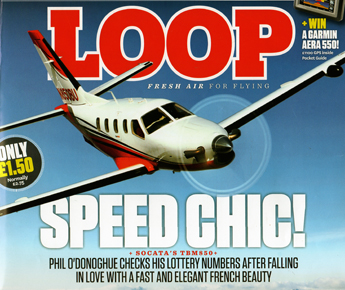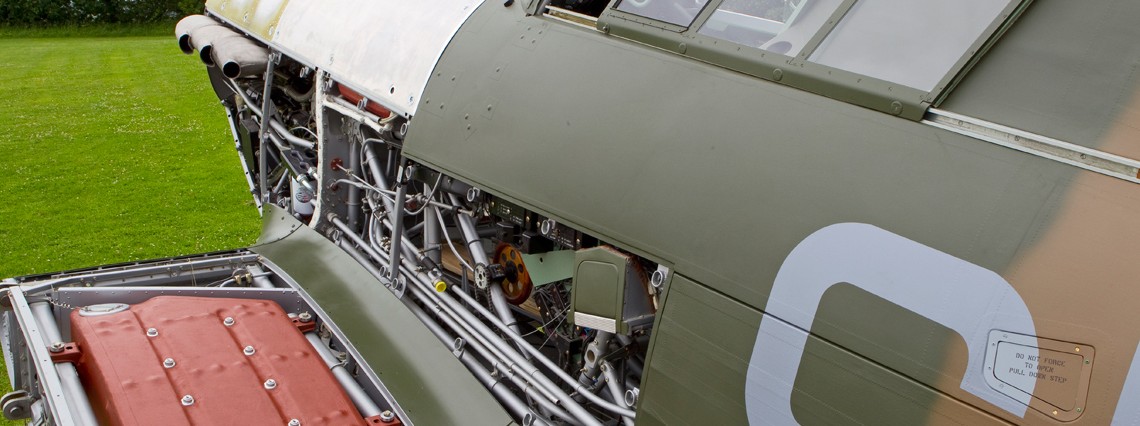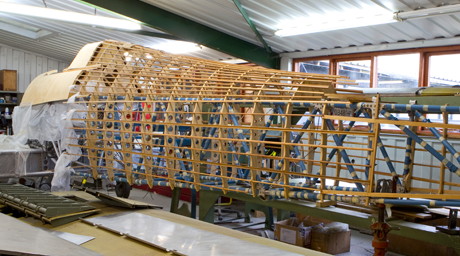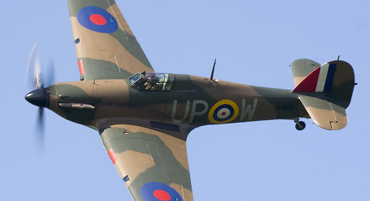www.loop.aero JANUARY 2010 LOOP
 Meet The UK’s Mr Hurricane
Meet The UK’s Mr Hurricane
Meet The UK’s Mr Hurricane There are only 11 Hawker Hurricanes in the world that are airworthy. Tony Ditheridge of Hawker Restorations is responsible for six of them. Not bad for someone who got into flying because of a bet…
Round the back of Moat Farm sits an innocuous looking barn where one might expect to find bales of hay or farming machinery. But open the doors and instead you’ll find an important chapter of British history as you’re met by the breath-taking sight of two naked Hurricane fuselages – numbers six and seven for Hawker Restorations.
Founded by Tony Ditheridge, Hawker Restorations began as a small three-man company: ‘I started life as an apprentice toolmaker at an instrument company in Cambridge. I was about half way through my apprenticeship when I’d taken an interest in electronics and the company I worked for made scanning electron microscopes (SEM). I graduated with three years of tool making and two years electronics experience. I ended up selling and repairing these machines all over the world.
‘I then started my own company working with an American and a Japanese firm selling SEM’s. After a few years the Japanese company took over and wanted to buy my company and have me as a director. They said they would do it with or without me. I called their bluff and they did it! So I sat in my office thinking what do I do now?
‘I had a couple of Stearmans in my workshop and started restoring them. I then hired Graham Self and Richard Watson – two very accomplished builders. So the three of us were rattling around the workshop waiting for something to happen. Then we met John “Jeff” Hawke who ran a company called Vision Air. He told us he had a contract from the Chilean Government to build a Bristol M1C for an air show to celebrate an event. We had to build it from scratch, test fly it and send it to Chile. And he said we had three months to do it.
‘So we thought, OK fine. We worked for three months and actually did it. We left Chile with an order for an Avro 504, SE5a and a Bleriot – so we were up and running.’
In the intervening years Hawker Restorations or AJD Engineering as they were then known, built 21 World War One aircraft plus several World War Two aircraft including a Spitfire, Corsair, Wild Cat, two Yak11’s and a two seat Spitfire. But the Hurricane is what really set Tony and his team apart from any other restorer; ‘I bought two Hurricanes in 1987 with the view to restore them. It turned out that they were a metallurgist’s nightmare. It became obvious very quickly that to get the material wand the tooling made was well beyond our budget. We needed several million pounds to get it done properly. So we sold our two Hurricanes and walked away completely.’
Tony was willing to walk away and forget about the Hurricane. It seems everyone that has tried to rebuild them before had ended up going bankrupt. But a previous project ended up being the turning point for the company. They had restored a World War One SE5A for Sir Tim Wallis and his Aircraft Museum based in Wanaka, New Zealand. Sir Tim phoned Tony and told him about a Hurricane he had found in the Murmansk area of Russia. The aircraft had crashed in the winter of 1943 and he asked Tony if he could restore it: ‘I told him we could do it but it wouldn’t be cheap. It would cost around £3m to rebuild the one aircraft. I said there was no point making a £3m aeroplane; we might as well build three £1m aeroplanes. There needed to be a huge investment in tooling and parts, so the overall cost would go down with each additional rebuild. It was going to be a leap of faith. People had tried it before and it’s always finished them.
‘Tim gave me a substantial cheque, told me get on with it and Hawker Restorations was started. I then bought the other two wrecks back as the guy had looked at them, changed his mind and was desperate to get rid of them. So I got them for half the price I sold them at.’
The Hurricane is a mechanically jointed aeroplane. Hawker didn’t believe in welded structures so it has to be very rigid, as Tony explains: ‘There is no latitude for building it wrong. If you get it wrong, it still looks the same. But in a very short period of time start to move about, fret and become very dangerous. The Hurricane is probably made up of a million parts and if you look at the drawings of each of those parts, the limits and fits are very, very tight. So once you’ve spent the money on the material science of having the spars made (a twelve sided tube over a circular tube) and once you’ve invested in the machining programmes and the skills of the people, building anything other than Hurricanes now would be pointless. The problem with the Hurricane is it’s all made of steel tube. Most of it will be scrap by the time we get it because it corrodes internally and externally. The main spars on the hurricane are 12-sided and one sits inside the other with a roll tube inside that. And they have to be an interference fit – one has to be slightly smaller than the other so when they clamp up them must lock in; to do that you need a lot of expensive tooling. If you look in the Hawker repair manual you can see how critical these parts are. They state that any corrosion, dent or scratch more than three-thousandth of an inch deems the spar unairworthy!
So you can see how difficult it is. All it would take would be for someone to accidently knock it with a screwdriver and that’s eight months work down the tube. That’s why people struggle to rebuild the Hurricane.’
Tony’s Hurricane workshop is filled with rack after rack of every conceivable part, either brand new or restored. There is everything from the entire fuselage of the third aircraft, awaiting reassembly, to each specific nut and bolt required to mount the Browning guns.
Although Tony and his team track down and buy any Hurricane they hear about, regardless of condition, more often than not end up with a buyer before they’ve even started the rebuild. People hear about the project long before the remains are back in their workshop, and offer to buy it straight away. Only one speculative aeroplane has been restored, all the others had a buyer before the project was underway.
Tony’s team of experts work full time and everyone is a fully qualified toolmaker who can use a milling machine and a lathe and can turn anything to within 3/10 of a thousandth of an inch in accuracy. This is Tony’s prerequisite for anyone who works with him.
‘We have old traditional skills here, which are necessary as we build traditional aircraft. For instance, all the tube squaring, milling, turning and fabrication of the undercarriage legs are done in-house. The prototypes are all made by hand on a lathe. Then we send them to another company to make several more, but we make sure the original is handmade. If someone can do it better than us, then we outsource it. Our tube-squaring machine was built from the original 1937 designs of an original Hawker machine, costing in excess of £10,000. The entire cowling rails around the engine start with round tubes, then you square them and then you put them through another set of rolls to shape them. So we had to manufacture all the rolls to put the funny shapes in.
‘Of the five Hurricanes we’ve built we have made every part. But we can often reclaim the major forged components. We normally used between 30 and 60% of the original aircraft. The most we managed to salvage was Peter Vacher’s MkI. His aircraft had remained in India since the war and hadn’t been touched and had been in a box since 1955. It was complete when we got it. But, even though the spars looked good, would anyone in their right mind use spars that are 60 years old in an aircraft worth around £2m? But it’s still 65% original. It takes a long time to reclaim all the original parts and can actually take longer than fabricating new parts.
‘Once I’ve built the final Hurricane I might retire. But there may always be another one round the corner. What we really want to restore, and have a passion for, is a Mosquito. We’ve looked at three around the world so far. It seems a shame there isn’t one flying for the Battle of Britain Memorial Flight. It’s one of the most iconic aircraft of the Second World War and I would bust a gut to build one.’
Tony’s Top 5 Tips
With all the knowledge Tony has gained over the years he knows a thing or two about building aircraft. here he offers a little insight into any homebuild project.
- Everything is in the planning. The building is important but the planning more so.
- Spend a lot of time analysing the feasibility, the amount of time you can spend on it, and your budget.
- Get advice from people you trust and who have already built the same type you intend to.
- At all stages liaise with the LAA or the CAA because you could finish the project and risk having to dismantle parts in order for the CAA or LAA to inspect and to approve the build.
- It’s very important to have a good workshop that is well lit and warm. If it’s warm you won’t mind being in there and it’ll be more suitable conditions for the building materials such as glue and wood. And make sure you’ve got a radio and kettle in there!
LATEST ARTICLES
Pilot’s Perspective – Hurricane I V7497/G-HRLI
Ask anyone to name an aircraft from World War Two and they’ll immediately say “Spitfire”, dig a little deeper though and you might just hear “Hurricane”. This is very...READ MORE
Hurricane I G-HRLI/V7497 Flies! ITV News Coverage
Following a lengthy restoration project, Hawker Hurricane Mk I V7497 took to the skies again on 31st August 2018. In the capable hands of Stu Goldspink, one of the...READ MORE










